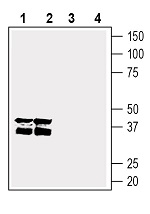Overview
- Peptide (C)RNRFILD(S)RMKQGIS, corresponding to amino acid residues 261 - 275 of mouse GPR55 (Accession Q3UJF0). 3rd extracellular loop.

 Western blot analysis of rat brain membranes (lanes 1 and 3), and mouse brain membranes (lanes 2 and 4):1, 2. Anti-GPR55 (extracellular) Antibody (#ACR-062), (1:500).
Western blot analysis of rat brain membranes (lanes 1 and 3), and mouse brain membranes (lanes 2 and 4):1, 2. Anti-GPR55 (extracellular) Antibody (#ACR-062), (1:500).
3, 4. Anti-GPR55 (extracellular) Antibody, preincubated with GPR55 (extracellular) Blocking Peptide (#BLP-CR062). Western blot analysis of mouse BV-2 microglia cell line lysate:1. Anti-GPR55 (extracellular) Antibody (#ACR-062), (1:500).
Western blot analysis of mouse BV-2 microglia cell line lysate:1. Anti-GPR55 (extracellular) Antibody (#ACR-062), (1:500).
2. Anti-GPR55 (extracellular) Antibody, preincubated with GPR55 (extracellular) Blocking Peptide (#BLP-CR062).
 Expression of GPR55 in rat substantia nigra.Immunohistochemical staining of perfusion-fixed frozen rat brain sections with Anti-GPR55 (extracellular) Antibody (#ACR-062), followed by goat anti-rabbit-AlexaFluor-488. A. GPR55 immunoreactivity (green) appears in the substantia nigra pars compacta (SNC) in neurons (arrows). B. Pre-incubation of the antibody with GPR55 (extracellular) Blocking Peptide (BLP-CR062), suppressed staining. Cell nuclei are stained with DAPI (blue). SNR = substantia nigra pars reticulata.
Expression of GPR55 in rat substantia nigra.Immunohistochemical staining of perfusion-fixed frozen rat brain sections with Anti-GPR55 (extracellular) Antibody (#ACR-062), followed by goat anti-rabbit-AlexaFluor-488. A. GPR55 immunoreactivity (green) appears in the substantia nigra pars compacta (SNC) in neurons (arrows). B. Pre-incubation of the antibody with GPR55 (extracellular) Blocking Peptide (BLP-CR062), suppressed staining. Cell nuclei are stained with DAPI (blue). SNR = substantia nigra pars reticulata.
- Mackie, K. and Stella, N. (2006) AAPS J. 8, 298.
- Lauckner, J.E. et al. (2008) Proc. Natl. Acad. Sci. U.S.A. 105, 2699.
- Hill, J.D. et al. (2018) Br. J. Pharmacol. 175, 3407.
- Shore, D.M. and Reggio, P.H. (2015) Front. Pharmacol. 6, 69.
- Sharir, H. and Abood, M.E. (2010) Pharmacol. Ther. 126, 301.
G protein coupled receptor 55 (GPR55) is a cannabinoid receptor activated by a number of endo‐, phyto‐ and synthetic cannabinoid ligands such as THC, JWH015 and anandamide1-3.
GPR55 is only 13.5% identical to the canonic cannabinoid receptor CB1 and 14.4% identical to CB2. Upon ligand binding, it initiates a signaling cascade quite distinct from those used by CB1 and CB2 that eventually leads to an increase in intracellular calcium levels.
GPR55 belongs to the Class A GPCRs. It shares many similarities with rhodopsin and as all other G-protein coupled receptors in its basic structure of seven transmembrane domains, intracellular C- terminus and extracellular N-terminal extensions4. The protein is highly expressed in large dorsal root ganglion neurons and its mRNA is present in the brain and periphery1.
GPR55 has a role in self‐renewing adult neural stem cell development and in hippocampal neurogenesis3. Experiments with mice in which GPR55 has been inactivated reveal a role for this receptor in neuropathic and inflammatory pain as well as in bone physiology. Thus deciphering the pharmacology of this receptor could lead to new therapeutics in these fields5.
Application key:
Species reactivity key:
Anti-GPR55 (extracellular) Antibody (#ACR-062) is a highly specific antibody directed against an epitope of the mouse protein. The antibody can be used in western blot and live cell flow cytometry applications. It has been designed to recognize GPR55 from human, rat, and mouse samples. The antibody will not recognize the human protein.

